PAGE 41 – SEPTEMBER 2005
All the Way from Here to There…
VISIBLY WORKING RAILROADS
Most small layouts focus on a single scene, usually a high-interest place
where goods or people are loaded or unloaded. The resulting train moves
away to an offstage area representng The Other End of the Line (or The
Rest of the World, for more ambitious modelers). Eventually it will return
to visibility. But some clever small layouts manage to show off both ends
of the line. They provide a visible demonstration that the road is at least
trying to earn its living. Here are a few good examples.
ELIMINATING THE MIDDLE
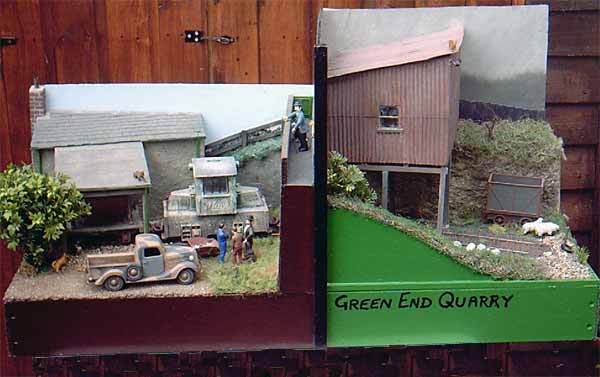
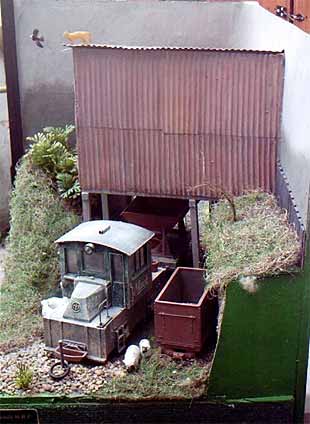 At the left, Bob’s small loco positions the vee-skip under the quarry tipple, where an Invisible Hand can fill it. (Notice the cat on the hot tin roof, whose dinner has just escaped!) Then the train journeys to the other end (below), where a hidden hook grasps the edge of the tip to empty it. For more, see Bob’s website.
At the left, Bob’s small loco positions the vee-skip under the quarry tipple, where an Invisible Hand can fill it. (Notice the cat on the hot tin roof, whose dinner has just escaped!) Then the train journeys to the other end (below), where a hidden hook grasps the edge of the tip to empty it. For more, see Bob’s website.
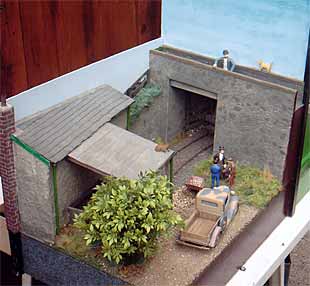
CONCOCTING A SHORT-HAUL LINE
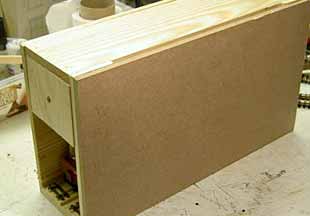
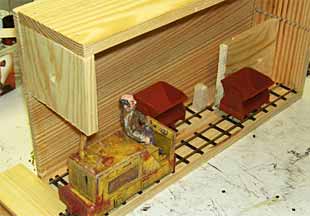
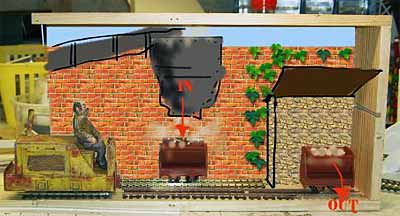 Conceptually, Martin’s layout will look like this. Trains are loaded with rock or gravel at the bin above the rear track, then pulled to the left onto a cassette (made from the box lid) which moves them over to the front track. They’re then pushed to the tip and emptied there. Martin, from Mansfield England, has more info at his website.
Conceptually, Martin’s layout will look like this. Trains are loaded with rock or gravel at the bin above the rear track, then pulled to the left onto a cassette (made from the box lid) which moves them over to the front track. They’re then pushed to the tip and emptied there. Martin, from Mansfield England, has more info at his website.TAKING AN ISOLATED EXAMPLE
 A different approach is to place the model railroad on an island and declare that the model is the entire line! There are several examples of such an island road in Scrapbook #36, and here’s another — Canon Island by Carsten Weye Jensen, from Holstebro Denmark.
A different approach is to place the model railroad on an island and declare that the model is the entire line! There are several examples of such an island road in Scrapbook #36, and here’s another — Canon Island by Carsten Weye Jensen, from Holstebro Denmark.
This N or Z scale road measures 15×12 in overall (385×305 mm), about a square foot by the time you cut the corners off. The fiction is that the line receives interchange cars by ferry, switches all the local destinations, then ships out loads and empties on the return ferry. By making a train turntable part of the village square, Carsten has managed to find a way to distribute traffic all around the island by simply turning on a dime in the middle (or is it on a krone?).
Carsten comments, “The ferry can hold two short cars, the turntable can hold a short car and a loco, and all the sidings except for the General Store can hold two cars, or a car and a loco. The ferry could also hold a motorized passengerwaggon [coach] and a very short (40mm) car.” Note: Scenery shown is designed to Z scale; the plan would also work in N scale using short-wheelbase rolling stock.
A ‘ROUND-THE-BEND APPROACH
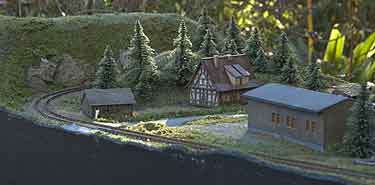

If a little more room is available, it’s possible to model both ends of the line and connect them with a length of track so the trains appear to travel some distance between termini. Graham Watling, from Norwich England, calls this an “up one side and down the other” type of railway using a central back screen — and his Sampson Vale layout is an excellent OO9/HOn30 example in 20×30 in (50×75 cm).
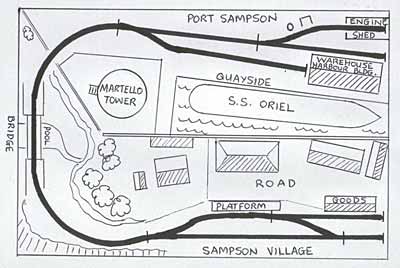 The line is a fictitious Channel Island railway connecting Sampson Village with Port Sampson and its quay. Graham built a high perimeter wall for the port area. and the train travels through an arch in the wall then over the bridge over a stream near a waterfall and round a bluff in the hillside into “Sampson Village” station. For operation at exhibitions, a railcar service alternates with a goods train usually hauling three wagons, which is shunted around at the Port on arrival. Two locos are needed at the Port to shunt wagons.
The line is a fictitious Channel Island railway connecting Sampson Village with Port Sampson and its quay. Graham built a high perimeter wall for the port area. and the train travels through an arch in the wall then over the bridge over a stream near a waterfall and round a bluff in the hillside into “Sampson Village” station. For operation at exhibitions, a railcar service alternates with a goods train usually hauling three wagons, which is shunted around at the Port on arrival. Two locos are needed at the Port to shunt wagons.
Graham’s wife, Caroline, made all the trees, gardens, and shrubland. Of particular interest is the model of a Martello Tower, visible in one of the photos, which is a fortification found on several of the Channel Islands, particularly Guernsey.
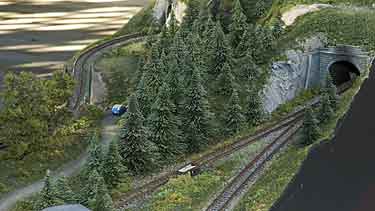
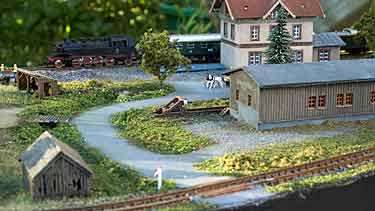
AND NOW FOR SOMETHING COMPLETELY DIFFERENT
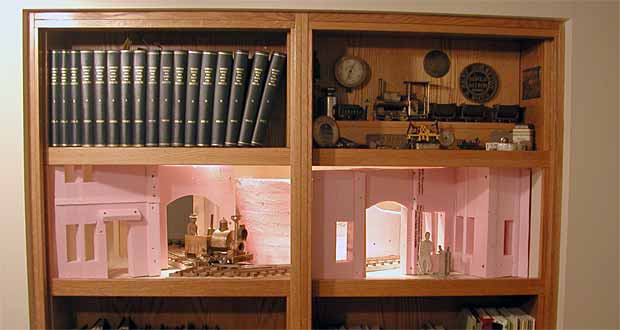
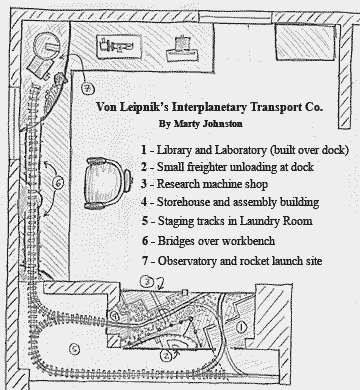 These are very large trains — the gauge between the rails is 45 mm (1.75 in), which represents a prototype two-foot gauge! Marty explains the plot this way: “Supplied by ship nine months of the year and serviced by a 2 ft tram, the site includes a machine shop, library, laboratory, rocket launch pad and observatory as well as a handful of other structures. It’s 1926 and Otto Von Leipnik is working hard to repeal the Second Law of Thermodynamics…”Some Details: The majority of the layout resides in a bookcase/wall that separates my modeling area from the laundry room. I am in the midst of completing the trackwork before I can move on to the buildings. On the right half of the bookcase scene you are looking out through the machine shop at the ship. The left-half of the scene opens onto the laboratory and library. In the dock area the tracks will be embedded in stone and wood.” For more details of this incredible construction, see Marty Johnston’s website! He lives in St. Paul, Minnesota USA.
These are very large trains — the gauge between the rails is 45 mm (1.75 in), which represents a prototype two-foot gauge! Marty explains the plot this way: “Supplied by ship nine months of the year and serviced by a 2 ft tram, the site includes a machine shop, library, laboratory, rocket launch pad and observatory as well as a handful of other structures. It’s 1926 and Otto Von Leipnik is working hard to repeal the Second Law of Thermodynamics…”Some Details: The majority of the layout resides in a bookcase/wall that separates my modeling area from the laundry room. I am in the midst of completing the trackwork before I can move on to the buildings. On the right half of the bookcase scene you are looking out through the machine shop at the ship. The left-half of the scene opens onto the laboratory and library. In the dock area the tracks will be embedded in stone and wood.” For more details of this incredible construction, see Marty Johnston’s website! He lives in St. Paul, Minnesota USA.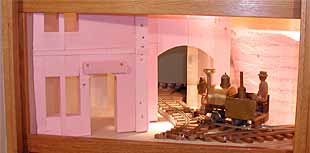
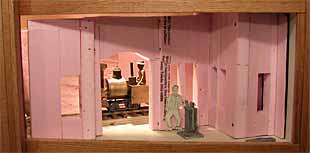
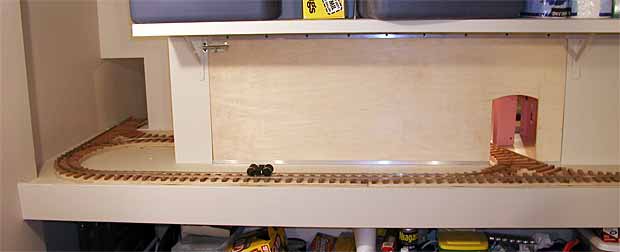
Leave a Reply